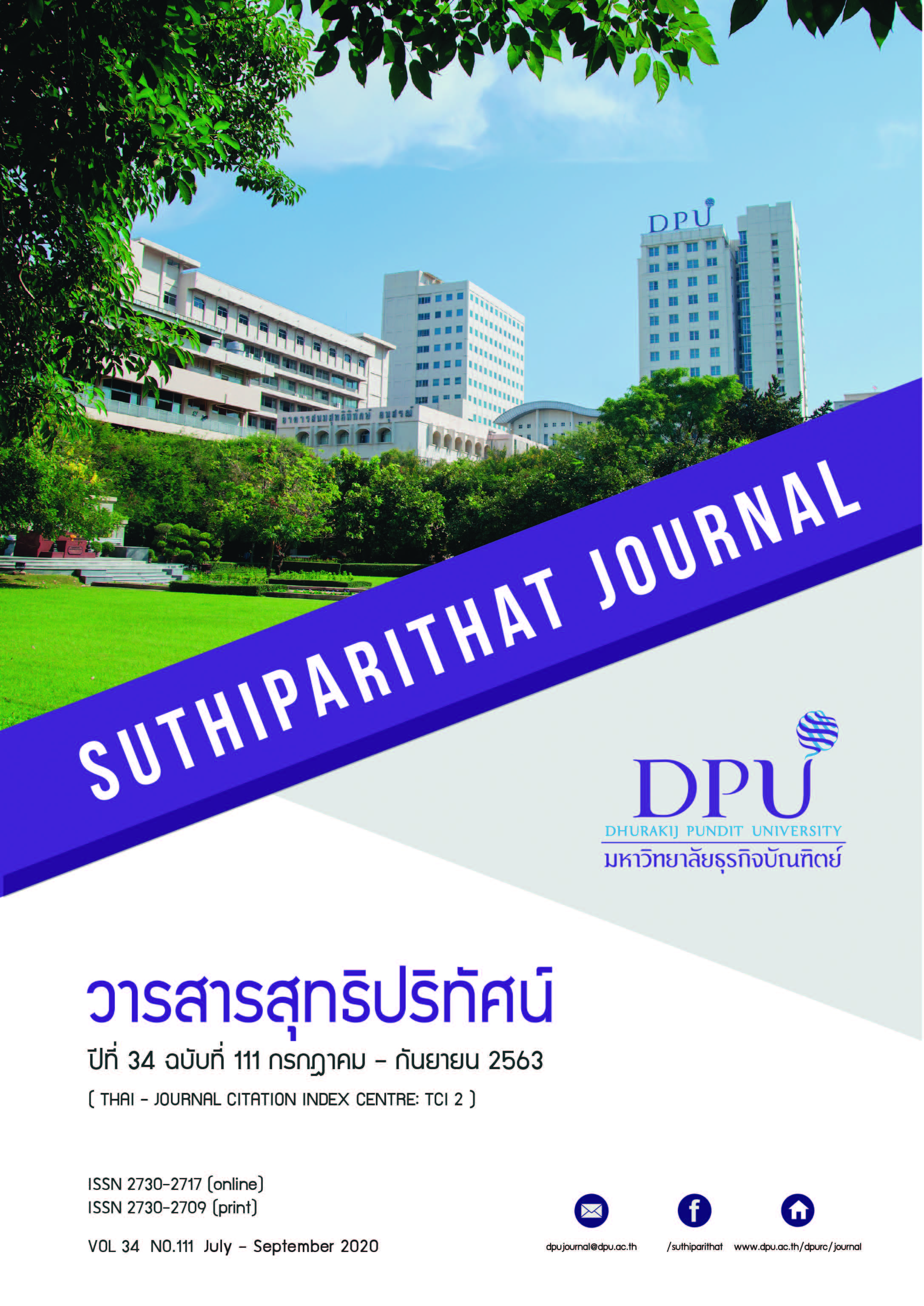ความเกี่ยวข้องกับการตัดสินใจของมูลค่าตามบัญชีต่อหุ้นและกำไรสุทธิต่อหุ้นวิธีมูลค่ายุติธรรมของอสังหาริมทรัพย์ เพื่อการลงทุน: บริษัทจดทะเบียนในตลาดหลักทรัพย์แห่งประเทศไทยกลุ่มอสังหาริมทรัพย์และก่อสร้าง
คำสำคัญ:
ความเกี่ยวข้องกับการตัดสินใจ, วิธีมูลค่ายุติธรรม, อสังหาริมทรัพย์เพื่อการลงทุนบทคัดย่อ
การศึกษานี้มีวัตถุประสงค์เพื่อเปรียบเทียบความสัมพันธ์ของกำไรสุทธิต่อหุ้น และมูลค่าตามบัญชีต่อหุ้นกับมูลค่ากิจการตามราคาตลาดระหว่างวิธีมูลค่ายุติธรรมและวิธีราคาทุนของกิจการในอุตสาหกรรมอสังหาริมทรัพย์และก่อสร้างโดยใช้ตัวแบบของ Feltham & Ohlson (1995) การศึกษานี้เป็นการวิจัยเชิงประจักษ์ (Empirical Research) โดยใช้วิธีการวิเคราะห์สหสัมพันธ์ (Correlation Analysis) และการวิเคราะห์การถดถอยเชิงพหุคูณ (Multiple Regression Analysis) ในการวิเคราะห์ข้อมูลซึ่งประกอบด้วยกลุ่มตัวอย่าง ตั้งแต่ปี 2556-2560 จำนวนทั้งสิ้น 477 ตัวอย่าง
ผลการศึกษาพบว่า (1) มูลค่าตามบัญชีต่อหุ้น กำไรสุทธิต่อหุ้นและสินทรัพย์รวมต่อหุ้นด้วยวิธีมูลค่ายุติธรรม สามารถพยากรณ์มูลค่ากิจการตามราคาตลาดได้ถึง 70.80% โดยตัวแปรทั้ง 3 ตัวข้างต้น สามารถพยากรณ์ราคาตลาดหลักทรัพย์ได้อย่างมีนัยสำคัญทางสถิติที่ระดับ 0.01 ทำให้ข้อมูลดังกล่าวมีความเกี่ยวข้องกับการตัดสินใจ (Value Relevance) ของผู้ลงทุน (2) มูลค่าตามบัญชีต่อหุ้น กำไรสุทธิต่อหุ้นและสินทรัพย์รวมต่อหุ้นวิธีราคาทุน สามารถพยากรณ์มูลค่ากิจการตามราคาตลาดได้ 66.80% โดยมีกำไรสุทธิต่อหุ้นเท่านั้นที่สามารถพยากรณ์ราคาตลาดหลักทรัพย์ได้อย่างมีนัยสำคัญทางสถิติที่ระดับ 0.01 (3) มูลค่าตามบัญชีต่อหุ้นวิธีมูลค่ายุติธรรมมีความสัมพันธ์กับมูลค่ากิจการตามราคาตลาดมากกว่าวิธีราคาทุน และ (4) กำไรสุทธิต่อหุ้นวิธีมูลค่ายุติธรรมมีความสัมพันธ์กับมูลค่ากิจการตามราคาตลาดน้อยกว่าวิธีราคาทุน
เอกสารอ้างอิง
กิตติมา อัครนุพงศ์. (2560). การเปรียบเทียบความเกี่ยวข้องในการกำหนดมูลค่าหลักทรัพย์ ของกำไรมูลค่าตามบัญชี และกระแสเงินสด หลักฐานเชิงประจักษ์จากบริษัทจดทะเบียนในกลุ่ม SET100 ในประเทศไทย. วารสารวิชาชีพบัญชี, 13(38), 95-114.
นพพร แพทย์รัตน์, และพัทธนันท์ เพชรเชิดชู. (2561). มูลค่าองค์กรกับการเปิดเผยข้อมูลตามรูปแบบของรายงานเชิงบูรณาการ (ปริญญานิพนธ์ปริญญาดุษฎีบัณฑิต). กรุงเทพฯ: มหาวิทยาลัยธุรกิจบัณฑิตย์.
ปัญญา สัมฤทธิ์ประดิษฐ์. (2545). การศึกษาปัจจัยที่มีผลกระทบต่อความสามารถของกำไรทางบัญชีและมูลค่าตามบัญชีในการใช้อธิบายราคาหลักทรัพย์หุ้นสามัญในตลาดหลักทรัพย์แห่งประเทศไทย (ปริญญานิพนธ์ปริญญาดุษฎีบัณฑิต). กรุงเทพฯ: จุฬาลงกรณ์มหาวิทยาลัย.
ปิยะรัตน์ โพธิ์ย้อย, และสุปรียา คงแสงชู. (2559). ความสัมพันธ์ระหว่างมูลค่าตลาดกับมูลค่าตามบัญชีกำไรต่อหุ้นและกระแสเงินสดจากการดำเนินงานในตลาดหลักทรัพย์แห่งประเทศไทย กล่มุ SET100. ใน การประชุมทางวิชาการระดับชาติ มหาวิทยาลัยเทคโนโลยีราชมงคลสุวรรณภูมิ ครั้งที่ 1.
พัทธ์ธีรา จิรอุดมสาโรจน์. (2560). ความสัมพันธ์มูลค่าราคาตามบัญชีกำไรต่อหุ้น และเงินปันผลของบริษัทที่จดทะเบียนในตลาดหลักทรัพย์แห่งประเทศไทย กลุ่มดัชนี SET 100. Journal of Thonburi University, 11(25), 99-106.
วัลลภ บัวชุม, และสุรศักดิ์ ดอนปัด. (2561). ความสัมพันธ์ของมูลค่าของกำไรทางบัญชีและมูลค่าตามบัญชีต่อราคาหลักทรัพย์ของบริษัทจดทะเบียนกลุ่มธุรกิจการเงินในตลาดหลักทรัพย์แห่งประเทศไทย. วารสารวิชาชีพบัญชี, 14(44), 55-67.
สภาวิชาชีพบัญชี ในพระบรมราชปูถัมภ์. (2558). กรอบแนวคิดสำหรับการรายงานการเงิน (ปรับปรุง 2558). สืบค้น ตุลาคม 2561, จาก http:www.fap.or.th.
สภาวิชาชีพบัญชี ในพระบรมราชูปถัมภ์. (2558). แม่บทการบัญชี (ปรับปรุง 2552). สืบค้น ตุลาคม 2561, จาก http:www.fap.or.th.
สภาวิชาชีพบัญชี ในพระบรมราชูปถัมภ์. (2560). มาตรฐานการบัญชีฉบับที่ 40 (ปรับปรุง 2560). สืบค้น ตุลาคม 2561, จาก http:www.fap.or.th.
สภาวิชาชีพบัญชี ในพระบรมราชูปถัมภ์. (2560). มาตรฐานการรายงานการเงินฉบับที่ 13 (ปรับปรุง 2560). สืบค้น ตุลาคม 2561, จาก http:www.fap.or.th.
Acaranupong, K. (2017). Accounting practices & value relevance of investment property: Evidence from firms listed on the Stock Exchange of Thailand. Asian Journal of Business & Accounting, 10(2), 1-41.
Argilés, J. M., Garcia-Blandon, J., & Monllau, T. (2011). Fair value versus historical cost-based valuation for biological assets: Predictability of financial information. Revista de Contabilidad, 14(2), 87-113.
Arouri, M. E. H., Bellalah, M., Hamida, N. B., & Nguyen, D. K. (2012). Relevance of fair value accounting for financial instruments: Some French evidence. International Journal of Business, 17(2), 209.
Badenhorst, W. M., Brümmer, L. M., & de Wet, J. H. V. (2016). The value-relevance of equity accounted carrying amounts & disclosed fair values of listed associates. Australian Accounting Review, 26(2), 177-189.
Ball, R., & Brown, P. (1968). An empirical evaluation of accounting income numbers. Journal of Accounting Research, 159-178.
Barth, M. E., Beaver, W. H., & Landsman, W. R. (2001). The relevance of the value relevance literature for financial accounting standard setting: Another view. Journal of Accounting and Economics, 31(1-3), 77-104.
Barth, M. E., Landsman, W. R., & Wahlen, J. M. (1995). Fair value accounting: Effects on banks’ earnings volatility, regulatory capital, & value of contractual cash flows. Journal of Banking & Finance, 19(3-4), 577-605.
Beaver, W. H. (1968). The information content of annual earnings announcements. Journal of Accounting Research, 67-92.
Beaver, W. H. (1981). Financial reporting: an accounting revolution. Englewood Cliffs, N.J.: Prentice Hall.
Beisland, L. A., & Knivsflå, K. H. (2015). Have IFRS changed how stock prices are associated with earnings & book values? Evidence from Norway. Review of Accounting and Finance, 14(1), 41-63.
Bricker, R., & Chandar, N. (2012). Relevance, reliability and restricted security fair values: a look at investment trusts. Managerial Finance, 38(12), 1203-1225.
Carroll, T. J., Linsmeier, T. J., & Petroni, K. R. (2003). The reliability of fair value versus historical cost information: Evidence from closed-end mutual funds. Journal of Accounting, Auditing & Finance, 18(1), 1-24.
Chen, C. (2011, September). Accounting quality: Choosing fair value versus historical cost. In 2011 International Conference on Management Science & Engineering 18th Annual Conference Proceedings, 890-895.
Danbolt, J., & Rees, W. (2008). An experiment in fair value accounting: UK investment vehicles. European Accounting Review, 17(2), 271-303.
Deans, S. (2007). Discussion of ‘Is fair value accounting information relevant & reliable? Evidence from capital market research’. Accounting and Business Research, 37(sup1), 31-32.
Drago, D., Mazzuca, M., & Trinca Colonel, R. (2013). Do loans fair value affect market value? Evidence from European banks. Journal of Financial Regulation and Compliance, 21(2), 108-120.
Fargher, N., & Zhang, J. Z. (2014, September). Changes in the measurement of fair value: Implications for accounting earnings. Accounting Forum, 38(3), 184-199.
Feltham, G. A., & Ohlson, J. A. (1995). Valuation & clean surplus accounting for operating & financial activities. Contemporary Accounting Research, 11(2), 689-731.
Frank, K. (2002). The effect of growth on the value relevance of accounting data. Journal of Business Research, 55(1), 69-78.
Gao, Y., Ma, L., & Fu, H. (2014). Study on the value relevance of investment real estate measured through the fair value pattern: Empirical research from the data of listed companies in China. In ICCREM 2014: Smart Construction & Management in the Context of New Technology, (pp. 1364-1371).
Gonçalves, R., Lopes, P., & Craig, R. (2017). Value relevance of biological assets under IFRS. Journal of International Accounting, Auditing and Taxation, 29, 118-126.
Graham, R. C., & King, R. D. (2000). Accounting practices and the market valuation of accounting numbers: Evidence from Indonesia, Korea, Malaysia, the Philippines, Taiwan, and Thailand. The International Journal of Accounting, 35(4), 445-470.
Hamdi, B., & Mejri, T. (2017). The value-relevance of banks’ fair value disclosures during the financial crisis: The case of European Banks. Comptabilité-Contrôle-Audit, 23(3), 29-62.
Hassan, M. S., & Mohd-Saleh, Norman. (2010). The value relevance of financial instruments disclosure in Malaysian firms listed in the main board of Bursa Malaysia. International Journal of Economics and Management, 4(2), 243-270.
Herrmann, D., Saudagaran, S. M., & Thomas, W. B. (2006, March). The quality of fair value measures for property, plant, and equipment. Accounting Forum, 30(1), 43-59.
Hitz, J. M. (2007). The decision usefulness of fair value accounting–a theoretical perspective. European Accounting Review, 16(2), 323-362.
Hodder, L., Hopkins, P., & Schipper, K. (2014). Fair value measurement in financial reporting. Foundations and Trends®. Accounting, 8(3-4), 143-270.
Kaya, C. T. (2013). Fair value versus historical cost: Which is actually more fair?. Journal of Accounting & Finance, 60.
Khurana, I. K., & Kim, M. S. (2003). Relative value relevance of historical cost vs. fair value: Evidence from bank holding companies. Journal of Accounting and Public Policy, 22(1), 19-42.
King, R. D., & Langli, J. C. (1998). Accounting diversity & firm valuation. The International Journal of Accounting, 33(5), 529-567.
Kothari, S. P., & Zimmerman, J. L. (1995). Price & return models. Journal of Accounting & Economics, 20(2), 155-192.
Kouki, A. (2015). Accounting valuation models under international financial reporting standards: evidence from some European listed companies. International Journal of Managerial & Financial Accounting, 7(1), 82-101.
Laux, C., & Leuz, C. (2009). The crisis of fair-value accounting: Making sense of the recent debate. Accounting, Organizations and Society, 34(6-7), 826-834.
McDonough, R. P., & Shakespeare, C. M. (2015). Fair value measurement capabilities, disclosure, & the perceived reliability of fair value estimates: A discussion of Bhat and Ryan. Accounting, Organizations and Society, 46, 96-99.
Milburn, J. A. (2008). The relationship between fair value, market value, and efficient markets. Accounting Perspectives, 7(4), 293-316.
Naimah, Z. (2012). Bias in accounting & the value relevance of accounting information. Procedia Economics and Finance, 2, 145-156.
Nellessen, T., & Zuelch, H. (2011). The reliability of investment property fair values under IFRS. Journal of Property Investment & Finance, 29(1), 59-73.
Ohlson, J. A. (1995). Earnings, book values, and dividends in equity valuation. Contemporary Accounting Research, 11(2), 661-687.
Owusu Ansah, S., & Yeoh, J. (2006). Relative value relevance of alternative accounting treatments for unrealized gains: Implications for the IASB. Journal of International Financial Management & Accounting, 17(3), 228-255.
Pinto, J. E., Robinson, T. R., & Stowe, J. D. (2019). Equity valuation: A survey of professional practice. Review of Financial Economics, 37(2), 219-233.
Qu, X., & Zhang, G. (2015). Value-relevance of earnings and book value over the institutional transition in China: The suitability of fair value accounting in this emerging market. The International Journal of Accounting, 50(2), 195-223.
Scott, W. R., & O’Brien, P. C. (2003). Financial accounting theory (Vol. 3). Toronto: Prentice Hall.
So, S., & Smith, M. (2009). Value relevance of presenting changes in fair value of investment properties in the income statement: Evidence from Hong Kong. Accounting and Business Research, 39(2), 103-118.
Tan, M. Z., Hassan, M. S., & Embong, Z. (2015). Value relevance of investment properties’ fair value and board characteristics in Malaysian real estate investment trusts. Asian Journal of Accounting and Governance, 5, 1-13.
Wang, Z., & Li, X. (2008, December). The system guarantee mechanism for the reliability of Fair Value: based on Game Theory. 2008 International Seminar on Business and Information Management, 1, 101-104. doi: 10.1109/ISBIM.2008.141
ดาวน์โหลด
เผยแพร่แล้ว
รูปแบบการอ้างอิง
ฉบับ
ประเภทบทความ
สัญญาอนุญาต
เนื้อหาและข้อมูลในบทความที่ลงตีพิมพ์ในวารสารสุทธิปริทัศน์ ถือเป็นข้อคิดเห็นและความรับผิดชอบของผู้เขียนบทความโดยตรงซึ่งกองบรรณาธิการวารสาร ไม่จำเป็นต้องเห็นด้วย หรือร่วมรับผิดชอบใด ๆ
บทความ ข้อมูล เนื้อหา รูปภาพ ฯลฯ ที่ได้รับการตีพิมพ์ในวารสารสุทธิปริทัศน์ ถือเป็นลิขสิทธิ์ของวารสารสุทธิปริทัศน์หากบุคคลหรือหน่วยงานใดต้องการนำทั้งหมดหรือส่วนหนึ่งส่วนใดไปเผยแพร่ต่อหรือเพื่อกระทำการใด ๆ จะต้องได้รับอนุญาตเป็นลายลักษณ์อักษรจากวารสารสุทธิปริทัศน์ก่อนเท่านั้น







